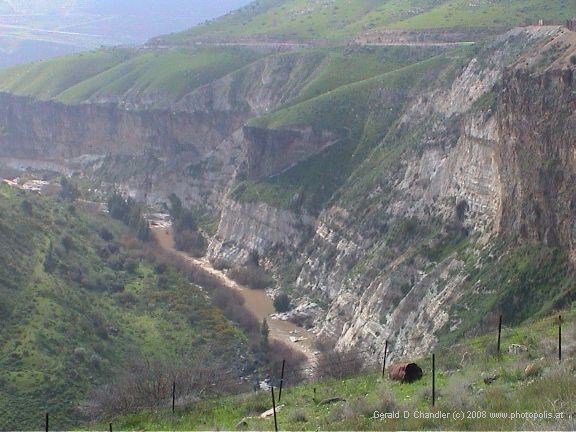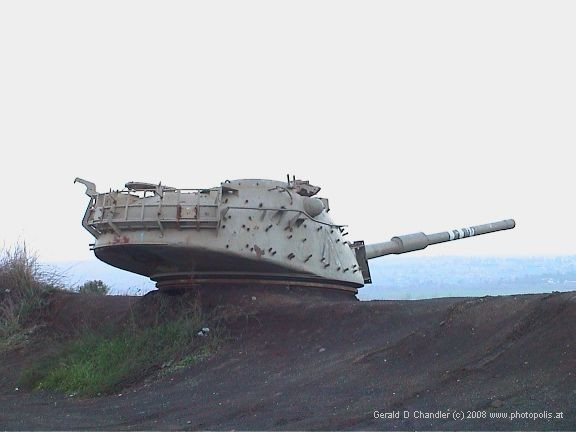Home | Front Page | Blog | Index | New | Contact | Site Map
Lincoln Apartment
Haas Promenade
Birthday Adventure
Galilee - Golan
North Med Coast
Empty Jerusalem
University Visits
Ein Karem
Foto Show
Public Forums
Are We Brave?
Refugee Camps

Egypt
Israel
Turkey
Bulgaria
Romania
Ukraine
Poland
Prague
Britain
USA 2002
Travel Map
We were traveling without real plans, other than to get to the Golan. We hadn’t read ahead and didn’t know what to expect and what was worth stopping at. We’d already passed “Belvoir”, or the sign to it, without knowing, as we later learned, that it was an important Crusader Castle with a beautiful view. But as we went through Beit She’an we saw a sign to the “National Park” and decided to turn off to investiage it. Very shortly thereafter we found the excavation of a Roman amphitheatre that apparently was intended as a hippodrome (horse racetrack).

Stadium seats at Beit She'an |
Beit She’an is located just to the west of the Sheikh Hussein Bridge, the northen-most Israel-Jordan crossing. We wanted to go see it, but as it was 20 km out of our way and as we’d proably be crossing there in late March and as we were hungry we continued straight north. A few kilometers south of Lake Kinneret we saw some hitch hikers and picked them up. They were two Israeli army girls, out of uniform. They told us that hitch hiking is only permitted to army personnel when out of uniform. Those in uniform have to make do with free bus rides.

Yarmuk Valley Gorge, Golan |
From there we drove up into the Golan heights, which quite reminded us of the North Yorkshire moors. We headed for Hamat Gader, the site of ancient Roman baths and saw it and the nearby cliffs of the Yarmuk valley; it was once in Syria and now has been annexed by Israel. Across the valley were the hills of Jordan; we also hope to hike there. We backtracked to Hwy 98 and ascended more of the Golan and stopped at “Peace Vista”, a kibbutz overlooking the Sea of Galilee with a hotel and restaurant, where we bought ice creams and a T-shirt for Gerry. Jan pointed out the shirt was a gift for his 60th birthday and Gerry got a lift when the woman acted as if she didn’t quite believe he was that old.

Arik! Arik! There's a tourist |
We then descended on Hwy 789 from the hills to Lake Kinneret (Galilee) and re-ascended on Hwy 869 to the village of Gamala and near it stopped for a view. There we met 4 young people, two guys and two girls, high or half high, and took their pictures. One of them, particularly amusing, got out his cell phone and said, “Arik, (nickname of Ariel Sharon), Arik. I’ve got amazing news. A tourist. There is a tourist in the Golan!” We had been looking for the nature reserve at Gamala, but that was another Gamala. So we continued on Hwy 869 to its intersection with Hwy 808 and there we picked up two more hitch hikers. As we drove with them we passed a crowd at what we now guess is Vulture’s lookout; missed that too.
Because time was running out we skipped Katsin, said to be the biggest town in the Golan. At the junction of Hwy 87 and Hwy 98 we came to the ruins of a town. We’d been asking ourselves, “Where did all of the Syrians go? If this territory was captured from Syria in 1967 how many of them had been here? Weren’t there any villages? Until now we had not seen the slightest hint of their traces. But here, whatever it was called, at this major junction were the decrepit remains of building after building, all in concrete. One was a large mosque with its identifying minaret still standing. But as we drove the km or so through “town” we noticed a pattern: the buildings didn’t look residential and weren’t lined up on streets. Rather quickly we made the guess this had not been a town; it had been a military base. Later, in our readings, we would learn that there had been many Syrian military bases on the Golan and that Israel had only won them by hard fighting.

Tank pointed toward Kunareit |
On Hwy 98 we continued north and soon came to a windturbine farm; we hadn’t known there were any in Israel. From there it was a short distance in the fading light to a place to view Kunareit, a town in Syria once captured by Israel and later given back. At Mas’ade, an Arab town, where the roads split and we could go west, we decided to start our return. It was our first Arab town since leaving Jerusalem and we again got a bit worried. Our first attempt to head for Kiryat Shmona was a failure; by mistake we got onto the road to Mt Hermon and only were sure of our mistake when, by the fading light, we could see the snows on its slopes. Until then we subconsiously found it hard to believe that a desert country could have snow. We made a u-turn and got lost again; our second attempt took us even closer to Mt Hermon; our third attempt did roughly the same, but on a different road. Jan’s worries had been gradually getting greater. The last thing she wanted was to be lost in the dark. Finally, when it was almost dark by dint of elimination we found the unmarked turn at a non-descript circle in Mas'ade that we had passed on our first attempt. From here the road climbed down, down, down to the coast. What a spectacular drive it must be in daylight.
Halfway to Kiryat Shmona we came across another group of hitchhikers, this time five young men in full military gear. They were at a bus stop, but hitch hiking because the buses had already stopped for the evening. They all wanted in, but we only had a little car, a four door Ford Fiesta, and only managed to get two and their gear in. But these two were incredibly grateful and kept saying how nice we were to pick them up. While their guns were obvious and sort of pointed at our backs we were more worried about their stepping on our camera which we’d left in the back. With their enormous weight the car handled much differently than it had been, almost fish tailing. However, as we entered Kiryat Shimona we heard a strange, almost growling sound. We had to get gas and there learned, by an almost accidental glance that that the left-rear tire was completely flat. So much for recognizing the obvious. We took the car over to the air pump and were happy to learn (unlike the US) that air still comes with no additional charge; we were even happier to learn that the tire could actually be reinflated and stayed inflated. No tire to change. Hurray.

Gerry on Jerusalem Street, Zafat |
At 17:00 our goal had been to get to the hilltop town of Zefat, look around, have dinner, and then drive back to Jerusalem. Now more than an hour later, well after dark, we let the soldiers off at the nearby town of Rosh Pina, and made for Zefat. Well, we were soon again thoroughly lost. Up, up, up we went, and ended on top of a hill, but not the Zefat hill. Then down, down, down. It was just like Thailand seven months earlier: in a rented car, in a place where we couldn't read the signs, and wondering when and how and if to admit defeat. Then, almost by accident, we were in or at least “about” Zefat. But try as we would, we could not find our way to the old, historic town where we wanted to walk. Our saviour was a dead end street: lost there, we saw a steep flight of steps and guessed it would lead to the area we wanted. We asked a passerby and it did. So we left the car and climbed the equivalent of 50 floors and found Jerusalem Street, the heart of the tourist area.
There, also by enormous luck, we found a place for a wonderful birthday meal. The food was the best we had yet had in Israel and still retains its title. And it came at a great price, NIS 33 ($7) each for what would have cost four times as much in Jerusalem. It consisted of home cooked soup, a meat dish, the best fries, fresh pita bread, and condiments. During dinner we decided that it would cost as much in gas to make a round trip to Jerusalem as to spend a night in Zafat. So with the restaurant owner’s help we made a reservation at the Peace Inn (Bet Shalom). We walked over the few blocks and were met on the main street by the aged, Yiddish speaking landlady. After paying her we went to get the car. It was easy to walk back to it and very difficult to find how to drive from the parking place to the guest house. After 2 1/2 tries we did it.

Retired man, self-taught jewelry maker |
Zafat is one of the holy cities of Israel. In the days before the founding of the state it was one of the four main centers of Jewish population. Friday morning was spent getting to know the old Jewish quarter of Zefat. Most of the story is sad: In ancient times, when people could not follow their faith openly in Jerusalem they often came to a more liberal Zefat. In Pre-independence days the minority Jewish population was harrassed by the Arab majority. By a miracle according to Jewish lights during the 1948 war a small Jewish force captured Zefat and the Arabs, 20,000 of them fled. They rightly call that a disaster. Outside oneof the ancient synagogues we met a Jewish veteran selling trinkets.